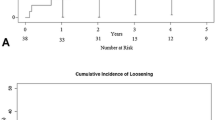Abstract
Background
Reverse shoulder arthroplasty (RSA) improves function in selected patients with complex shoulder problems. However, we presume patient function would vary if performed primarily or for revision and would vary with other patient-specific factors.
Questions/purposes
We compared (1) the shoulder scores and (2) complications in patients with RSA for revision arthroplasty with patients who had RSA as a primary procedure; and (3) identified patient-specific factors that affect (1) and (2).
Patients and Methods
We retrospectively compared 28 RSAs for failed arthroplasty with a control group consisting of 28 primary RSAs. We determined the Penn Shoulder (PENN), American Shoulder and Elbow Surgeons (ASES), and Single Assessment Numeric Evaluation (SANE) scores. Followup for shoulder outcome measures averaged 17.4 (range, 4.1–34) and 20.8 months (range, 7.3–34.9) for the study and control groups, respectively.
Results
All scores were higher in primary RSA than in revision RSA (PENN score, 79.5 versus 57.1; ASES score, 81.4 versus 56.3; SANE score, 73.8% versus 48.8%), and ROM was better (122.7° versus 83.75°). Both groups experienced increases in active forward flexion. Ten of the 28 study RSAs (35.7%) versus five of the 28 control RSAs (17.8%) had complications. No patient-specific factors other than reason for surgery correlated with scores.
Conclusions
Revision RSA is associated with lower function compared with primary RSA. However, we believe it a reasonable alternative and patients undergoing RSA for revision arthroplasty can expect improvements in function and shoulder scores to a mean of 50% of normal shoulders but must also accept a high complication rate.
Level of Evidence
Level III, therapeutic study. See the Guidelines for Authors for a complete description of levels of evidence.
Similar content being viewed by others
References
Boileau P, Watkinson D, Hatzidakis AM, Hovorka I. Neer Award 2005: The Grammont reverse shoulder prosthesis: results in cuff tear arthritis, fracture sequelae, and revision arthroplasty. J Shoulder Elbow Surg. 2006;15:527–540.
Cuff D, Pupello D, Virani N, Levy J, Frankle M. Reverse shoulder arthroplasty for the treatment of rotator cuff deficiency. J Bone Joint Surg Am. 2008;90:1244–1251.
Grammont PM, Baulot E. Delta shoulder prosthesis for rotator cuff rupture. Orthopedics. 1993;16:65–68.
Leggin BG, Michener LA, Shaffer MA, Brenneman SK, Iannotti JP, Williams GR. The Penn shoulder score: reliability and validity. J Orthop Sports Phys Ther. 2006;36:138–151.
Richards RR, An KN, Bigliani LU, Friedman RJ, Gartsman GM, Gristina AG, Iannotti JP, Mow VC, Sidles JA, Zuckerman JD. A standardized method for the assessment of shoulder function. J Shoulder Elbow Surg. 1994;3:347–352.
Sirveaux F, Favard L, Oudet D, Huquet D, Walch G, Molé D. Grammont inverted total shoulder arthroplasty in the treatment of glenohumeral osteoarthritis with massive rupture of the cuff. Results of a multicentre study of 80 shoulders. J Bone Joint Surg Br. 2004;86:388–395.
Wall B, Nové-Josserand L, O’Connor DP, Edwards TB, Walch G. Reverse total shoulder arthroplasty: a review of results according to etiology. J Bone Joint Surg Am. 2007;89:1476–1485.
Werner CM, Steinmann PA, Gilbart M, Gerber C. Treatment of painful pseudoparesis due to irreparable rotator cuff dysfunction with the Delta III reverse-ball-and-socket total shoulder prosthesis. J Bone Joint Surg Am. 2005;87:1476–1486.
Williams GN, Gangel TJ, Arciero RA, Uhorchak JM, Taylor DC. Comparison of the Single Assessment Numeric Evaluation method and two shoulder rating scales. Outcomes measures after shoulder surgery. Am J Sports Med. 1999;27:214–221.
Acknowledgment
We thank Ashish Joshi, MD, MPH, for his assistance in statistical analysis.
Author information
Authors and Affiliations
Corresponding author
Additional information
One of the authors (GRW) is a consultant and owns stock in DePuy Orthopedics Inc (Warsaw, IN), is a consultant for DePuy Mitek (Chesterfield, MO), owns stock in InVivo Therapeutics (Cambridge, MA), and receives royalties from Lippincott Williams & Wilkins (Philadelphia, PA).
Each author certifies that his or her institution has approved the human protocol for this investigation and that all investigations were conducted in conformity with ethical principles of research.
About this article
Cite this article
Austin, L., Zmistowski, B., Chang, E.S. et al. Is Reverse Shoulder Arthroplasty a Reasonable Alternative for Revision Arthroplasty?. Clin Orthop Relat Res 469, 2531–2537 (2011). https://doi.org/10.1007/s11999-010-1685-x
Published:
Issue Date:
DOI: https://doi.org/10.1007/s11999-010-1685-x




